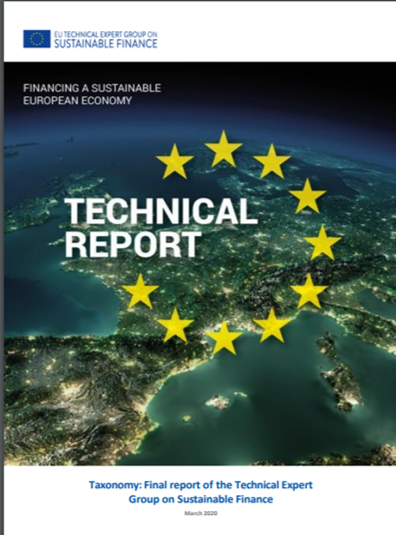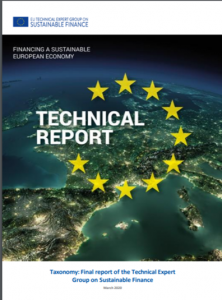EU Taxonomy Final Report
Posted on: March 23rd, 2020

Sustainable Finance Taxonomy report ‘Financing a Sustainable European Economy’
 Technical Report published 9 March 2020
Technical Report published 9 March 2020
On 9 March 2020 the EU TEG (Technical Expert Group) on sustainable finance produced their final report which sets out a ‘taxonomy’ of sustainable business activities. This significant development will help investors to recognise those business activities that should be regarded as ‘sustainable’.
Well worth reading – as time permits – in these strange times!
- The full report can be downloaded here.
- UNPRI video and commentary here. Further information on www.unpri.org/eu-taxonomy .
- EU Sustainable Finance overview (with multiple links) here.
The report starts as follows:
AT A GLANCE
The EU Taxonomy is a tool to help investors, companies, issuers and project promoters navigate the transition to a low-carbon, resilient and resource-efficient economy.
The Taxonomy sets performance thresholds (referred to as ‘technical screening criteria’) for economic activities which:
• make a substantive contribution to one of six environmental objectives (Figure 1);
• do no significant harm (DNSH) to the other five, where relevant;
• meet minimum safeguards (e.g., OECD Guidelines on Multinational Enterprises and the UN Guiding Principles on Business and Human Rights). The performance thresholds will help companies, project promoters and issuers access green financing to improve their environmental performance, as well as helping to identify which activities are already environmentally friendly.
In doing so, it will help to grow low-carbon sectors and decarbonise high-carbon ones. The EU Taxonomy is one of the most significant developments in sustainable finance and will have wide ranging implications for investors and issuers working in the EU and beyond.
Relevance for financial services intermediaries
I would guess that few financial advisers and other intermediaries will rush to use the taxonomy straight away (if ever), however it is likely to prove useful over time.
This document is complex and detailed – and sets out the need for further work that must be done to assess additional related areas (eg ‘brown’ activities) This is likely to continue to evolve over time and my hope would be that in due course the UKs position will also become entirely clear. In spite of this lack of clarity I’d suggest this will soon become a valuable tool for many in the investment community who wish to support the transition towards lower carbon economies so well worth familiarising yourself with. The following are some initial thoughts on areas to focus on:
3.3 – Financial Market Participants
The following were most obviously relevant – section 3.3.2 (‘which investment products’?) and 3.3.3 (Narrative Disclosure)…
Section 3.3.2 sets out the products the Taxonomy disclosure obligations will apply to, which are: UCITS funds (Equity, ETF & Bond funds), Alternative Investment Funds, Porftolio Management, Pensions (see p38)
Section 3.3.3 Narrative disclosures
The TR requires investors to disclose:
How and to what extent the investments underlying the financial product are invested in environmentally sustainable economic
activities.
This narrative is an important companion to the quantitative (percentage) disclosure requirements.
For general disclosures (i.e., not seeking specific accreditation or labelling), there is no ‘correct’ percentage of Taxonomyaligned securities in a fund, but investors may wish to explain elements of their strategy or approach in the narrative, especially
where the percentage is low. For example:
• Products targeting companies whose ESG performance is low but improving over time may wish to describe the methods
used to identify and engage companies and the expected time frame for that improvement.
• For products using a different methodology for determining environmental performance, the TEG considers that best
practice to explain the strategy, its environmental objectives and main points of variance from the Taxonomy.
• The investor may also wish to explain how it considers metrics, such as Taxonomy-aligned capex, when evaluating the
sustainability of underling investments and their trajectory towards the criteria.
• Investors who appoint external fund managers may wish to disclose details of how they use the Taxonomy when engaging
with these external managers.
Section 5 – p58 Taxonomy summary
This detailed table sets out different activities that are relevant to the taxonomy – pointing hopefully to easier conversations to be had in due course about ‘who does what’ in the sustainable investment fund market.
Decoding the report
Some of the key acronyms in the report are:
The report makes regular reference to NACE codes. This stands for ‘Nomenclature statistique des activités économiques dans la Communauté européenne’ which is a European industry standard classification system. These activities and their selected sectors total 93.2% of greenhouse gas emissions (according to recent information published online by Allen & Overy).
DNSH is also used regularly to describe business activities that ‘Do not Significant Harm’
SC – stands for Significant Contribution (to addressing climate change/reducing emissions)
TR – stands for Taxonomy Regulation